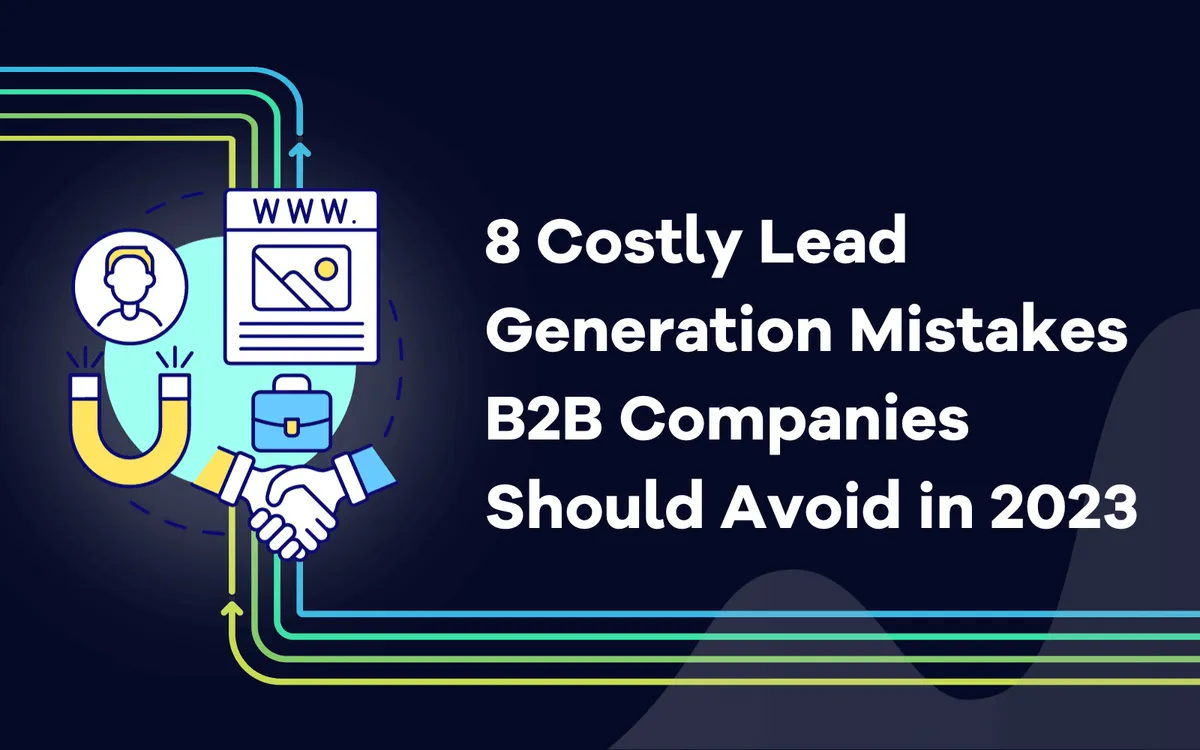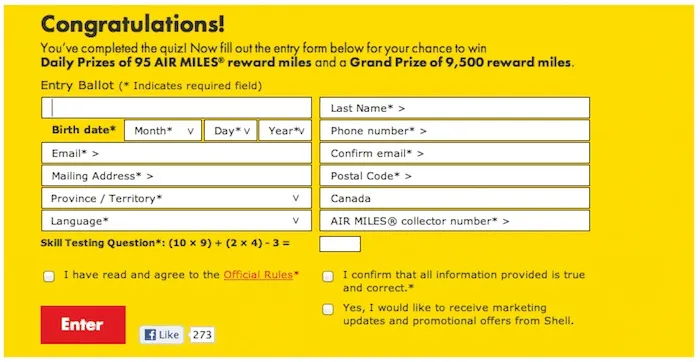
8 Costly Lead Generation Mistakes B2B Companies Should Avoid in 2023

Antonio Gabrić
September 28, 2023
Learn how to steer clear of common pitfalls and supercharge your business growth with our expert insights.

For most B2B companies, lead generation is what gets the sales ball rolling. It's the first, most crucial step to ensuring businesses survive and thrive. And yet, the odds of getting lead generation right are about as high as winning the giant teddy bear in a rigged carnival game.
It's either a problem of too few leads, or too many low-quality ones, they could be taking forever to convert, or dropping out of the funnel just when you think you’ve got a deal. And the worst part? You have no idea what you’re doing wrong.
From misunderstanding the nuances of target audiences to underestimating the power of well-optimized content, there could be so many overlooked factors causing your sales pipeline to stagnate.
But in a world where every click, interaction, and engagement is precious, it's imperative to recognize the potential traps that can jeopardize lead gen efforts and organizational goals.
In this article, we’ll look at some of the costliest lead generation mistakes B2B companies are making, and how to set them right.
Why lead generation matters
The most important part of any marketer's job is to increase sales, and acquiring new customers is a key aspect of that.
In 2021, a Gartner study listed lead generation as the top digital marketing goal for the next year.
Ironically, lead generation was also the biggest challenge faced by marketers in 2022.
Finding the faults in your company's lead generation process and then fixing them is a formidable task, but if you can pull it off, the pay-offs are immense.
Here are a few case studies for inspiration:
Lead generation success stories
Fixing its email deliverability rate (from 42.9% to 99%) helped a commercial real estate company to close a $1M deal.
Software testing company Tricentis built a $5M+ sales pipeline in less than six months by redefining its paid media target audience.
Matmatch, an engineering materials marketplace, grew its user base from a few thousand to over 150K users by pursuing a LinkedIn-based ABM strategy.
8 Costly Mistakes B2B Companies Make During Lead Generation
Lead generation won't fix all the problems your business has, but the revenue it generates is the next best thing that could happen to any organization.
These are the pitfalls you need to avoid if you want to reap the most benefits out of your lead gen strategy.
Not Segmenting Leads
For leads, the messages easiest to respond to are the ones that sound as though they were written just for them.
But unless you're working with a handful of leads, creating custom messages for each isn't possible.
You can, however, segment leads into carefully created sections, and then use these individually or in combination with other segments to create hyper-personalized campaigns.
Start by segmenting leads according to the offer they accepted or converted on.
Further refine segments using their niche or industry, location, organization size, job title, behavioral data, and previous interactions.
In your messages, address pain points that affect them directly. You can make them more effective by using other segment data.

For example, if you know they use Salesforce, make sure to mention that your product has a Salesforce integration. If they operate out of Texas, include a case study of a Texas-based client in your email to establish a connection.
Lead segments also help you decide where, when, and how often to follow up. You can then continue guiding them along the buyer's journey with targeted messages tailored to their preferences and needs.
Not Using A Dedicated Landing Page
Say you're shown an ad for a thriller on YouTube. You click on the Watch Now link only to be redirected to Netflix's homepage, with countless listings for every genre under the sun. Or a page for a different movie altogether.
That doesn't make for an enjoyable experience, does it?
When leads click on an ad or a lead magnet, they have tunnel vision. All they care about is getting what they were promised.
So when you redirect them to your homepage, or any page other than what they're looking for, they'll bounce off your website and into the arms of a competitor who's not playing games with them.
A dedicated landing page that matches the offer made in your ad or lead magnet paves the way for a faster, higher conversion rate.
Don't crowd it with multiple CTAs or lengthy sign-up forms.
If it's mobile-optimized and responsive, you score a few more brownie points.
And you can lower your bounce rate further by incorporating exit intent pop-ups to re-engage departing leads.

Not Making A Compelling Offer
You wouldn't buy the same birthday present for your golfing buddy, your mum, and your eight-year-old nephew. Because while Pokémon cards might be a hit with your nephew, the other two might not take to them as enthusiastically.
You could be making an extremely generous offer to your lead, but unless it’s relevant and packaged in a way that appeals to them, they won’t take it.
Use buyer personas to create tailor-made offers that suit the different sensibilities of different ICPs.
When you’re creating lead magnets, for example, keep in mind that the segment of leads that prefer podcasts might never even glance at your free ebook offering. Create multiple offers in the form of ebooks, webinars, podcasts, free trials, etc. to maximize your lead generation potential.
Poor ask-to-offer ratios can also turn off leads, so aim to balance the value offered with the effort required.
Continuing our earlier ebook example, a lead will give you their email address in exchange for your resource, but they won’t give away their organization’s revenue, their CFO’s biggest challenges, and their childhood pet’s name, so consider that when designing your sign-up form.

Not having A Diverse Content Strategy
Content marketing is one of the most powerful tools to get high-intent leads in your sales funnel. But not all leads are in the same stage of their buyer journey.
If you’ve only been publishing generic content to attract a wider audience, it can be off-putting to a lead looking for technical information for a purchase.
In contrast, hyper-specific, niche content will go undiscovered by or be incomprehensible to leads still in the discovery stage.
The key to offering valuable content to leads is understanding what their problems are, and offering relevant, useful, and actionable information to solve those problems.
Stage of Funnel
Type of Content
Top-of-funnel leads
Blog Posts, Infographics, Social Media Posts, Webinars, Podcasts, Quizzes and Surveys
Middle-of-funnel leads
Case Studies, Interactive Tools, Comparison or Buyer Guides, Expert Interviews, Product Videos
Bottom-of-funnel leads
Product Trials, Customer Testimonials, Pricing Guides, Limited Time Offers, Special Discounts
If you stay committed to
not overpromising,
being upfront, and
giving before you ask
you’ll win yourself a loyal, engaged audience.
Not Conveying Credibility and Trust
Let’s face it. People aren’t exactly going to line up to be a business’s lab rat/guinea pig/first-ever paying customer.
Because no one wants to shell out hundreds of thousands of dollars for a product with an unproven track record.
As much as we may harp on the need to be individualistic and think for ourselves, most of us have a herd mentality. Wherever the crowd goes, we follow.
And it doesn’t help that customers everywhere trust a peer’s word much more than a marketer’s.
To prevent the lack of trust signals from unraveling your campaign, solicit lead and customer feedback at every possible opportunity.
Not only do customer testimonials and success stories boost your reputation, but they also offer you one-of-a-kind insights into your ability to meet expectations.
Have a time-bound mechanism to collect feedback in the form of ratings, opinions, and suggestions, especially after successful projects.

Use the social proof, referrals, and endorsements generated to drive conversions
in ad copy,
on landing pages,
as case studies on your blog,
in social media posts,
as part of free resources, etc.
Not Utilizing The Omnichannel Approach
Most audiences hang out on more than one channel, and they expect you to be there too. And not in a barely there, posts once in six months, manner.
They, or at least 73% of the surveyed consumers for a Zendesk survey, want you to plunge headlong into multiple channels and provide them with a seamless omnichannel experience, where they can start a conversation with you on LinkedIn, and pick it up on Twitter, without having lost any data or context.
And the benefits are huge.
Expanding the number of channels you actively search and pursue leads on creates multiple touch points for you to:
Discover new leads
Build stronger ties with existing leads
And give them a firsthand experience of your customer service.
These touchpoints could include your website, email campaigns, social media posts, virtual and physical events, etc.
Identify best-performing channels and slowly integrate them with less popular ones. Promote high-traffic blog posts in emails and on social media, and include links to your newsletter sign-up page on viral social media posts.
While doing all this, ensure brand consistency across channels by using the same logo, design, and tone of voice.
Not Nurturing Leads
Lead generation is not a one-time event. Between the time they first become aware of your brand to the time they make a purchase, leads have to slowly and steadily be reminded of your value proposition and their need for your product.
Try to sell too hard or too fast, and you might end up losing the lead forever.
In order to nurture leads without rushing them, you'll need to employ a mix of strategies like content marketing, personalization, multi-channel distribution, and automation.
After the first few trial and errors, you’ll be able to grasp the pattern most lead segments follow — from initial contact to conversion.
Create and automate your email sequence using a tool like Hunter Campaigns.

Use lead scoring to determine which leads to target and incorporate other channels into your outreach to double down on your messaging.
As leads try to make a purchase decision, they will move back and forth in their back journey, making it a non-linear transition.
Keep your lead nurturing approach flexible enough to enable you to connect with leads at any given moment, no matter where they are in their buyer journey.
Not Measuring and Testing Results
Complicated, long-drawn processes like lead generation can throw up a lot of data. There are KPIs to track, individual channels to monitor, A/B tests to run — it's enough to overwhelm anyone.
But start by determining which KPIs you'd like to improve. Are your acquisition values too high? Would you like to reduce the time taken to convert? Focus on one or two problem areas.
Then study your most important acquisition channel. If it's your website and blog, use Accuranker's keyword tracker and competitor analysis tools to review SEO performance and optimize content strategy.

With it, you can discover more powerful keywords to attract the right audiences and stay ahead of industry trends.
Use A/B tests to pitch two landing pages, pop-ups, or emails against each other.
Pay attention to email open and click-through rates to see what kind of content converts best.
If these email addresses are verified, that can contribute further to making lead tracking more precise and improving deliverability rates.
Constant tracking and monitoring of all these data points will help you bag every possible lead and increase content ROI.
Wrapping Up
Checking for these eight mistakes should make it easier for you to pinpoint the problem areas in your current lead generation process.
Whether it's through classifying leads, redirecting them to relevant pages, tailoring content and offers to their preferences, providing social proof, reaching out to them on a channel of their choice, building warm connections with personalized and consistent messaging, or using data collection tools to replicate and scale past successes, every lead generation mechanism can be repaired and refined.
With a solid value proposition to boot, you'll be invincible.
Related blog posts

5 LLM Visibility Metrics You Should Track in 2026
SEO is now both about ranking in search engines and being visible in LLMs. We give you five visibility metrics every SEO should track in 2026.
3 December 2025Is LLM Tracking Relevant for You?
LLM tracking is not just for SEOs. It is also relevant for content teams, agencies, marketing leadership, and communication teams. Learn why here.
26 November 2025
How to Find the Best Prompts to Track for AI Visibility
Do you want to start tracking prompts to optimize your AI visibility? We give you seven practical ways to identify relevant prompts to track in LLMs.
9 November 2025
